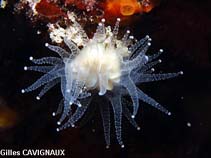Caryophyllia inornata (Duncan, 1878)
| Native range | All suitable habitat | Point map | Year 2050 |

|
| This map was computer-generated and has not yet been reviewed. |
| Caryophyllia inornata AquaMaps Data sources: GBIF OBIS |
Classification / Names Common names | Synonyms | CoL | ITIS | WoRMS
Hexacorallia | Scleractinia | Caryophylliidae
Environment: milieu / climate zone / depth range / distribution range Ecology
Reef-associated. Subtropical
Distribution Countries | FAO areas | Ecosystems | Occurrences | Introductions
Eastern Atlantic and the Mediterranean.
Length at first maturity / Size / Weight / Age
Maturity: Lm ? range ? - ? cm
Short description Morphology
The stony coral are not colonial. Vertical size skeleton reaches 0.25 mm, its section is round; at base not narrowed in normal conditions. End of the tentacles forming a small spherical bludgeon brown; white or pink polyps (Ref. 358).
Vertical skeleton size: 0.25 cm (Ref. 358).
Life cycle and mating behavior Maturity | Reproduction | Spawning | Eggs | Fecundity | Larvae
Members of the class Anthozoa are either gonochoric or hermaphroditic. Mature gametes are shed into the coelenteron and spawned through the mouth. Life cycle: The zygote develops into a planktonic planula larva. Metamorphosis begins with early morphogenesis of tentacles, septa and pharynx before larval settlement on the aboral end.
Main reference
References | Coordinator | Collaborators
Göthel, H. 1992. (Ref. 358)
IUCN Red List Status (Ref. 130435: Version 2024-1)
CITES status (Ref. 108899)
Appendix II: International trade monitored
CMS (Ref. 116361)
Not Evaluated
Threat to humans
Human uses
| FishSource |
Tools
More information
Trophic Ecology
Food items
Diet
Food consumption
Ration
Predators
Diet
Food consumption
Ration
Predators
Ecology
Population dynamics
Life cycle
Distribution
Human Related
Aquaculture profile
Stamps, Coins Misc.
Stamps, Coins Misc.
Outreach
References
Internet sources
BHL | BOLD Systems | CISTI | DiscoverLife | FAO(Publication : search) | Fishipedia | GenBank (genome, nucleotide) | GloBI | Gomexsi | Google Books | Google Scholar | Google | PubMed | Tree of Life | Wikipedia (Go, Search) | Zoological Record
Estimates based on models
Preferred temperature
(Ref. 115969): 10.5 - 18.3, mean 12.2 (based on 114 cells).
Price category
(Ref. 80766):
Unknown.



